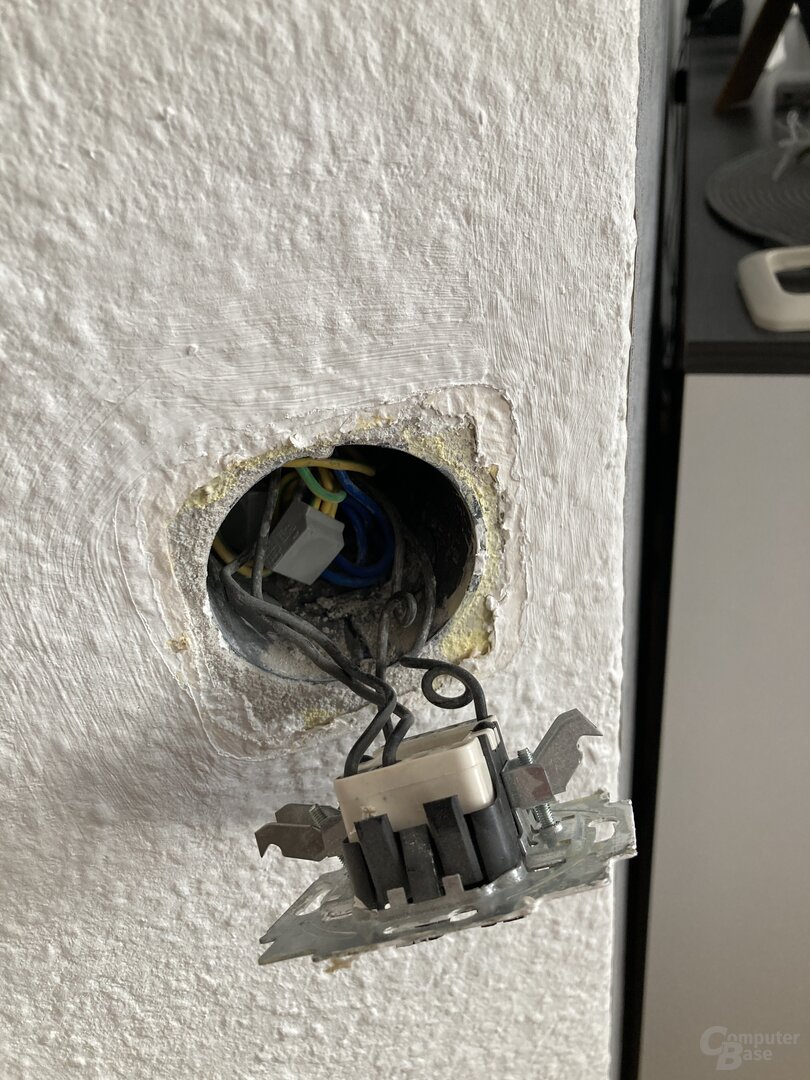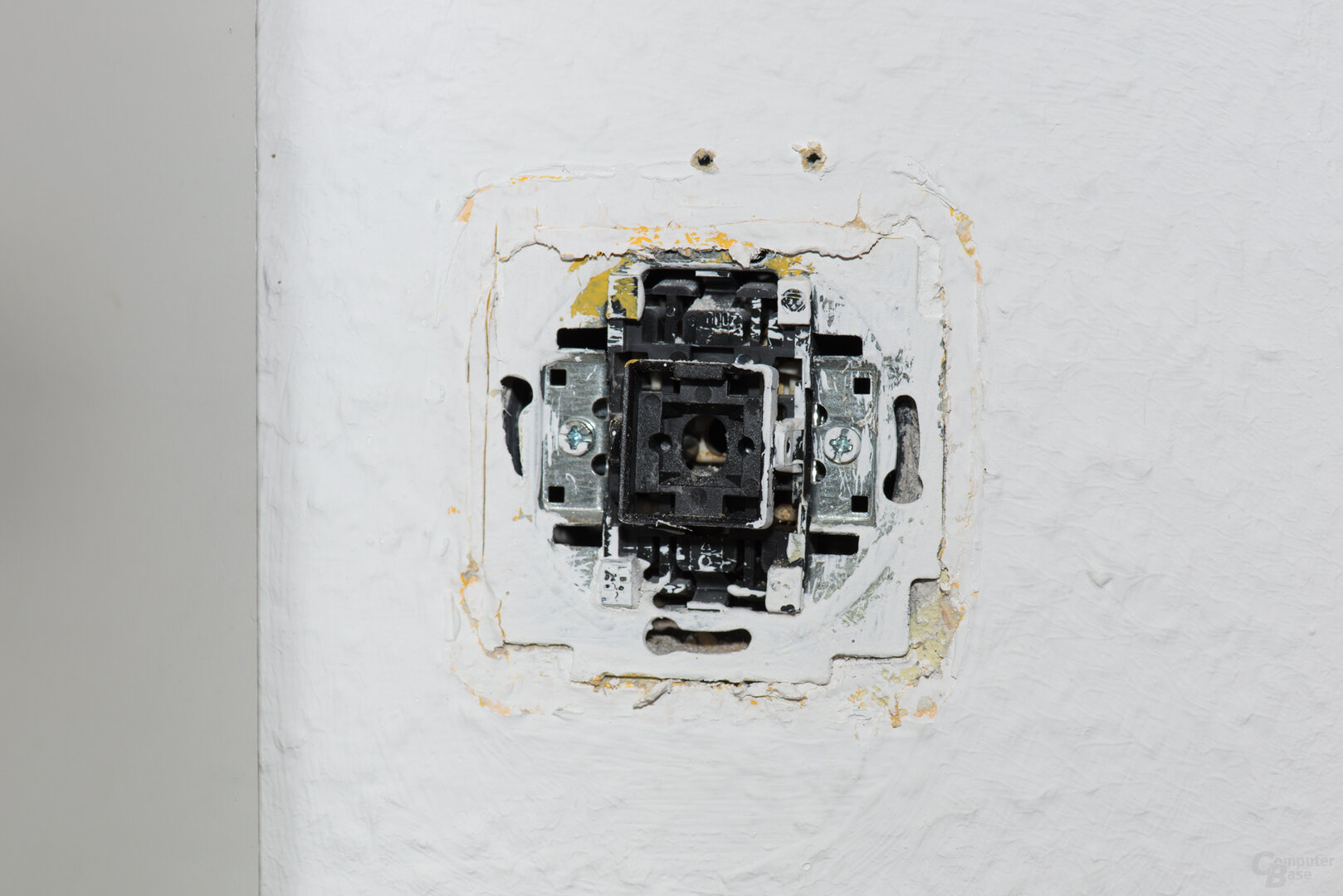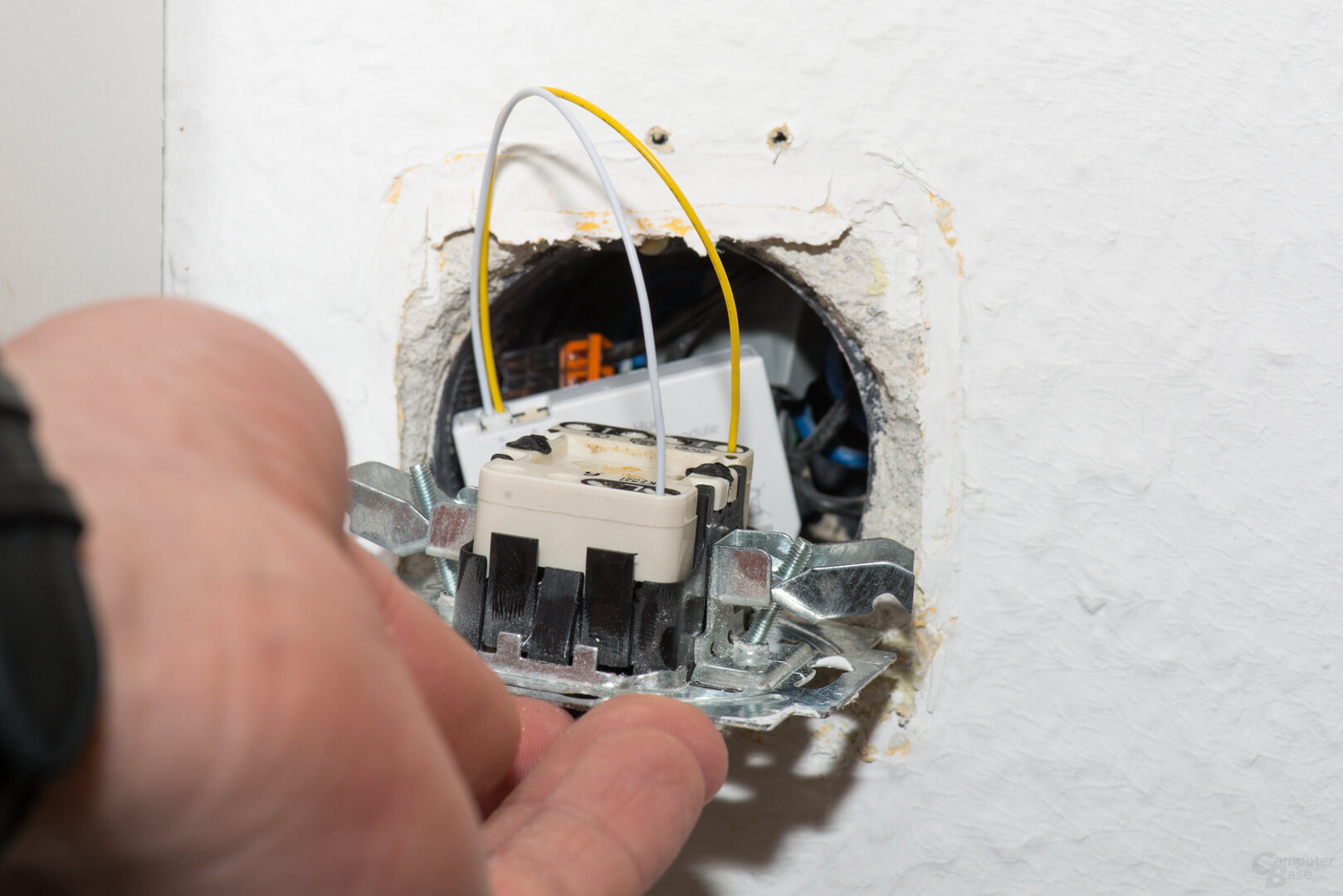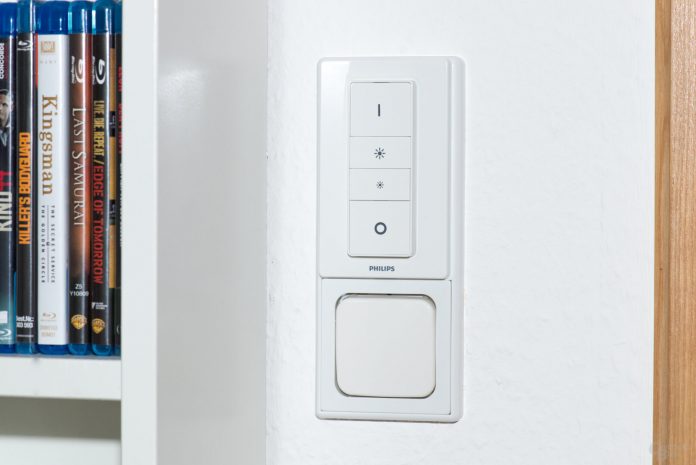With the Philips Hue wall switch module, Signify is tackling a long-standing problem with its smart Hue lights. Ceiling lights are often accidentally switched off and can no longer be addressed by the network due to the permanently required power supply.
Table of contents
- 1 The problem with the wall switch
- Differences to Shelly as well as Zigbee and Z-Wave actuators
- The module in detail
- Installation
- Everyday experiences and conclusion
- Expensive solution (for a problem?)
- Other possible uses
The problem with the wall switch
Smart lighting requires a permanent power supply, so the conventional wall switch must always remain in its switched-on position so that the user can control or time-switch the smart lighting. Visitors who do not know that are all the more surprised if nothing happens when the ceiling light is supposed to be switched off – and have cut the power supply to the smart light permanently.
In doing so, guests often have no choice but to reach for the counter. But even those who could control it via app or voice command occasionally reach for the switch (if the power supply is first disconnected and then restored, the Hue lamps are activated), because it is faster, or because there is no smartphone at hand is.
Keeping the switch has advantages. The only thing that should be prevented is that inexperienced users use it incorrectly.

< p class = "p text-width">To solve the problem, users made use of various methods. For example, there are cover frames that hide the (switched on) switch, but the handle must then necessarily be made using the “smart” method. Or the Philips Hue remote control (Hue dimmer) is placed near the switch. There are even switch panels that bring the holder for the remote control with them.
The most expensive alternatives are special switch series compatible with Hue: Even the simplest model from Busch-Jaeger As a double rocker, however, costs around 70 euros.
Differences to Shelly as well as Zigbee and Z-Wave actuators
So-called Shellys or Zigbee and Z-Wave actuators are also widely used in the Hue community, but they rely on a different mode of operation. All three are connected to the power circuit of the lamp and control the power supply to the end device. The classic switch can continue to interrupt the power supply, but it can also be restored remotely via the app.
The Shelly module works via WLAN and therefore does not address the Hue Bridge directly. Further coupling with HomeKit, for example, must be learned. The Z-Wave or Zigbee actuator, on the other hand, works with the Hue Bridge and – depending on the actuator – is listed in the Hue app as a socket or lampAlthough a Zigbee actuator comes close to the functionality of the Hue wall module, there are a few things to watch out for. Zigbee actuators cannot be used universally. There are actuators for single and double buttons as well as switches and these both with and without dimming function. Another important fact is that, compared to the Hue module, the actuator absolutely needs a neutral conductor, which is missing in older electrical wall installations. In addition, the common actuators with dimensions of around 45 × 45 × 20 mm are also a lot larger than the wall module (43.3 × 38 × 10.2 mm) and so do not necessarily fit behind every wall switch = “p text-width”>Another major disadvantage of Zigbee actuators is that they often require a minimum load from the connected lamp. If this load is higher than the consumption of the connected lamp, problems can arise when switching. However, the actuator also has something ahead of the Hue wall module: it does not require any Hue light sources, but is compatible with all conventional light sources.
ComputerBase also tested a Z-Wave implementation with the Devolo flush-mounted switch.
The module in detail
Only with Hue lamps
Signify provides a remedy here with the Philips Hue wall switch module. Compared to actuators from third-party suppliers, it is not the power supply that is controlled, only the switching signal. However, this approach does not only have advantages.
The trump card of the Hue wall module is first of all the extremely easy integration into the existing Hue system. Since it is not the power supply but the switching signal that is tapped, the ceiling lamp can also be dimmed without any problems or reproduce different scenes when switched. When it comes to dimming, there are problems with actuators and Shellys, as the light source plays a role as well as the module. Speaking of light sources: This is where the biggest “disadvantage” of the wall module can be found. If Shelly and Zigbee actuators can work with almost any ceiling light, the Hue wall module requires Hue light sources due to the way it works. Since communication takes place via Zigbee (3.0), a Hue bridge is also required, which also excludes the control of lights via Bluetooth.
 On the square in pay attention to the flush-mounted box – here; too little space
On the square in pay attention to the flush-mounted box – here; too little space The small module must be placed in the flush-mounted box behind the light switch. Before installation, it is essential to pay attention to the depth and the available space in the box. The small module uses a button cell battery of the type CR2450 for signal transmission. According to the manufacturer, this should be sufficient for at least five years, but the entire switch must be removed when changing the battery.
It is gratifying that the wall switch module can also operate with double switches and buttons. For the former, the scope of delivery includes the small module and a Wago plug-in terminal, two connection cables.
The Philips Hue wall switch module should be available from spring 2021, but it has not yet been shown not in trade. It is initially only available through direct sales through Philips. For the individual module, Philips calls for a price recommendation of around 40 euros. In a double pack, 70 euros, i.e. 35 euros per piece, are due.
Installation
Attention, danger to life: To install the Philips Hue wall switch module, work on electrical lines is necessary. It is therefore imperative to cut the power supply via the fuse or the main switch before starting the installation. In case of doubt, the installation should only be carried out by a trained specialist.
After the power supply has been cut, the installation of the Hue wall switch module can be done easily within a few minutes. First remove the rocker switch and the frame with the help of a small slotted screwdriver. The same applies to the now exposed changeover switch insert, the retaining clips of which can be loosened using cross-head screws. Inexperienced users should now note or note the clamping sequence of the connected cables before they are released from the changeover switch. The cut line is closed with a Wago clamp. In the last step, the module and the toggle switch are connected with the enclosed cable and inserted into the socket.
In addition to the installation video, Philips also describes the individual steps in an illustrated description (PDF ).
-
 View of the changeover switch insert, without rocker and frame
View of the changeover switch insert, without rocker and frame
Image 1 of 5
 View of the changeover switch insert, without rocker and frame
View of the changeover switch insert, without rocker and frame  Detached changeover switch insert
Detached changeover switch insert  View into the flush-mounted box
View into the flush-mounted box  Wired Hue wall module
Wired Hue wall module In the Hue app, the integration of the module is just as easy as usual. The module is added to the system as a new accessory in the settings tab. After a short search, it will be found and integrated without any problems. Afterwards, only the type of switch (single or double toggle switch) and the controlled room have to be selected – that's it. In the settings of the module, simple switch-on or switch-on with a scene change can also be set.
-
 Philips Hue wall switch module: Integration in the Hue app
Philips Hue wall switch module: Integration in the Hue app
Image 1 of 3
 Philips Hue wall switch module: Integration in the Hue app
Philips Hue wall switch module: Integration in the Hue app  Philips Hue wall switch module: Integration in the Hue app
Philips Hue wall switch module: Integration in the Hue app  Philips Hue wall switch module: integration in the Hue app
Philips Hue wall switch module: integration in the Hue app everyday experiences and conclusion
The Philips Hue wall switch module keeps what it promises: It prevents the permanent power supply of smart ceiling lights from being cut off. The wall switch can also be operated by unsuspecting guests without worrying about the ceiling lamp being disconnected from the mains. Compared to the alternatives mentioned for Shelly, Z-Wave and Zigbee actuators or Hue dimmers, the module is the simplest solution to make the conventional light switch smart.
Installation and app integration of the wall switch module are easy and can also be mastered by unskilled users. The only downer is that the associated lamp must have a Hue light source. In this point, Z-Wave or Zigbee actuators have an advantage: They allow the use of conventional light sources, but certain requirements such as size, minimum load, neutral conductor and functional type must be observed with the actuators.
Expensive solution (for a problem?)
Another sticking point of the Philips Hue solution is the high purchase price of 40 euros. If you consider that the dimmer remote control in a bundle with an E27 lamp can often be found for around 20 euros. So that the Philips Hue wall switch module can secure a larger group of buyers, the street price should be between 20 and 30 euros – after all, it is only an accessory gadget for the already expensive Hue system. The Zigbee actuators can also be found in this price range. And then there would be the question of the scope of the problem to be solved: Does it really happen that often that Hue lights go offline?
Other uses conceivable
Regardless of this, the module is a very good addition to existing Hue systems. The possible application scenarios do not just end with ceiling lights. The module can just as easily be used independently. Connected to any toggle switch, the team can act as a remote control – although the conventional Hue dimmer is also more suitable and cheaper here.
Do you use smart light sources (app control) in your four walls?
- Yes, but not everywhere where it is possible
- Yes, everywhere where it is possible is
- No
- Abstain (show result)
Please log in to vote!
A room that only has a ceiling light and a light switch, but is equipped with additional accent lights, can also be controlled with ease. Here the simple light switch can be replaced by a double switch and both can be connected to the module so that one switch is used for the ceiling light and the other switch for the other lamps.
ComputerBase has that Philips Hue wall switch module borrowed for testing. The manufacturer did not exert any influence on the test report, and there was no obligation to publish it. There was no NDA.
This article was interesting, helpful, or both? The editors appreciate every support from ComputerBase Pro and deactivated ad blockers. More about advertisements on ComputerBase.


